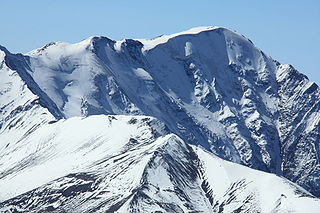
In biological classification, subspecies is a rank below species, used for populations that live in different areas and vary in size, shape, or other physical characteristics (morphology), but that can successfully interbreed. Not all species have subspecies, but for those that do there must be at least two. Subspecies is abbreviated subsp. or ssp. and the singular and plural forms are the same.

The roe deer, also known as the roe, western roe deer, or European roe deer, is a species of deer. The male of the species is sometimes referred to as a roebuck. The roe is a small deer, reddish and grey-brown, and well-adapted to cold environments. The species is widespread in Europe, from the Mediterranean to Scandinavia, from Scotland to the Caucasus, and east as far as northern Iran.

The mouflon is a wild sheep native to Cyprus, the Caspian region from eastern Turkey, Armenia, Azerbaijan, and Iran. It is thought to be the ancestor of all modern domestic sheep breeds.

The urial, also known as the arkars or shapo, is a wild sheep native to Central and South Asia. It is listed as Vulnerable on the IUCN Red List.

The wild goat is a wild goat species, inhabiting forests, shrublands and rocky areas ranging from Turkey and the Caucasus in the west to Turkmenistan, Afghanistan and Pakistan in the east. It has been listed as near threatened on the IUCN Red List and is threatened by destruction and degradation of habitat.
Turkification, Turkization, or Turkicization describes a shift whereby populations or places received or adopted Turkic attributes such as culture, language, history, or ethnicity. However, often this term is more narrowly applied to mean specifically Turkish rather than merely Turkic, therefore referring to the Ottoman Empire, and the Turkish nationalist policies of the Republic of Turkey toward ethnic minorities in Turkey. As the Turkic states developed and grew, there were many instances of this cultural shift.

Hirkan National Park — is a national park of Azerbaijan. It was established in an area in Lankaran Rayon and Astara Rayon administrative districts on February 9, 2004 on the basis of the former "Hirkan State Reserve" which it superseded, on a surface area of 29,760 hectares (297.6 km2). It was enlarged by presidential decree on April 23, 2008 from 29,760 hectares (297.6 km2) to 40,358 hectares (403.58 km2).

Panthera pardus tulliana is a leopard subspecies native to the Iranian Plateau and surrounding areas encompassing Turkey, the Caucasus, Azerbaijan, Georgia, Armenia, Iraq, Iran, Turkmenistan, Afghanistan and possibly Pakistan. Since 2016, it has been listed as Endangered on the IUCN Red List, as the wild population is estimated at less than 1,000 mature individuals.

The Armenian mouflon is an endangered subspecies of mouflon endemic to Iran, Armenia, Nakhchivan Autonomous Republic of Azerbaijan, Turkey and Iraq.
Ovis orientalis may refer to:

The wildlife of Azerbaijan consists of its flora and fauna and their natural habitats.

Shahdag National Park — is a national park of Azerbaijan. It was established on an area of 115,900 hectares (1,159 km2) in the Quba Rayon, Qusar Rayon, İsmayıllı Rayon, Qəbələ Rayon, Oğuz Rayon and Şamaxı Rayon administrative districts on December 8, 2006. It was enlarged by presidential decree on July 8, 2010 from 115,900 hectares (1,159 km2) to 130,508.1 hectares (1,305.081 km2).

In biology, taxonomic rank is the relative level of a group of organisms in an ancestral or hereditary hierarchy. A common system of biological classification (taxonomy) consists of species, genus, family, order, class, phylum, kingdom, and domain. While older approaches to taxonomic classification were phenomenological, forming groups on the basis of similarities in appearance, organic structure and behaviour, methods based on genetic analysis have opened the road to cladistics.
Sarcocystis is a genus of parasitic Apicomplexan alveolates. Species in this genus infect reptiles, birds and mammals. The name is derived from Greek: sarkos = flesh and kystis = bladder.

Dilijan National Park is one of the four national parks of Armenia. Occupying an area of 240 km², it is located in the north-eastern Tavush Province of Armenia. It is known for its forest landscapes, rich biodiversity, medicinal mineral water springs, natural and cultural monuments, and extensive network of hiking trails.
Minorities in Turkey form a substantial part of the country's population, representing an estimated 25 to 28 percent of the population.

Place name changes in Turkey have been undertaken, periodically, in bulk from 1913 to the present by successive Turkish governments. Thousands of names within the Turkish Republic or its predecessor the Ottoman Empire have been changed from their popular or historic alternatives in favour of recognizably Turkish names, as part of Turkification policies. The governments have argued that such names are foreign or divisive, while critics of the changes have described them as chauvinistic. Names changed were usually of Armenian, Greek, Georgian, Laz, Bulgarian, Kurdish (Zazaki), Syriac, or Arabic origin.

The Trans-Caucasian fox is a subspecies of the red fox, found in the Kurdistan and Armenian Highlands but also parts of Asia Minor and Iran.
The eastern part of the current territory of the Republic of Turkey is part of the ancestral homeland of the Armenians. Along with the Armenian population, during and after the Armenian genocide the Armenian cultural heritage was targeted for destruction by the Turkish government. Of the several thousand churches and monasteries in the Ottoman Empire in 1914, today only a few hundred are still standing in some form; most of these are in danger of collapse. Those that continue to function are mainly in Istanbul.
















